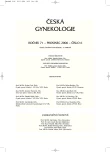Cardiovascular Risk and Estrogens
Authors:
J. Franeková 1; Peter Koliba 2; A. Jabor 3; A. Pohlídal 1; Z. Holub 4
Authors‘ workplace:
Ústav klinické biochemie, Fakultní nemocnice s poliklinikou, Ostrava – Poruba
přednosta MUDr. A. Pohlídal, PhD.
1; Gynekologická klinika, Fakultní nemocnice s poliklinikou, Ostrava – Poruba
přednosta MUDr. P. Koliba, CSc.
2; Úsek laboratorních metod, IKEM Praha, vedoucí prof. MUDr. A. Jabor, CSc.
3; Gynekologicko-porodnické oddělení, Oblastní nemocnice Kladno, primář doc. MUDr. Z. Holub, CSc.
4
Published in:
Ceska Gynekol 2006; 71(6): 483-489
Category:
Original Article
Overview
Objective:
To describe relations among postmenopause, hormonal therapy, lipid metabolism and risk of cardiovascular diseases.
Design:
Search and analysis of relevant data from medical literature.
Methods:
Analysis of the relation between serum lipid profile and postmenopausal changes, evaluation of positive and negative effects of estrogens on vascular wall and lipid metabolism, analysis of methods for the assessment of cardiovascular risk and evaluation of recent guidelines.
Results:
Postmenopause is connected with significant changes in lipid metabolism, serum lipid profile and with increased risk of cardiovascular diseases. Deficit of estrogens influences lipid metabolism negatively. However, estrogen substitution has both positive and negative effects on vascular wall. Negative effects are: increased occurence of postprandial hyperlipidemia with increased triglycerides, generation of aterogenous small dense LDL particles, increased risk of inflammatory changes in vascular wall and procoagulation situation.
Conclusion:
Hormonal therapy can display some positive effects of vascular wall. However, recent data evaluate hormonal substitution with regard to atherosclerosis and cardiovascular problems as less benefitial or even risky.
Key words:
postmenopause, lipid profile, hormonal substitution, atherosclerosis, cardivasular diseases
Labels
Paediatric gynaecology Gynaecology and obstetrics Reproduction medicineArticle was published in
Czech Gynaecology

2006 Issue 6
Most read in this issue
- Clinical Comparison of Laparoscopy-Assisted Vaginal Hysterectomy (LAVH) and Total Laparoscopy Hysterectomy (TLH) in Women with Benign Disease of Uterus – a Prospective Randomized Study
- Hormonal Contraception Possible Interactions
- Placenta and Annexin V Receptors, Antibodies against Annexin V and against Other Phospholipids in Patients with Recurrent Pregnancy Loss
- The Impact of Total Abdominal and Laparoscopically Assisted Vaginal Hysterectomy on the Development of Urine Incontinence
